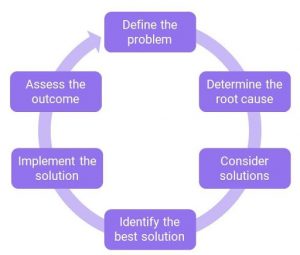
Exploring the Four Stages of Effective Decision-Making
Effective decision-making drives efficient teams, organisations and even personal projects. Although we make up to 35 000 decisions a day, there are some decisions that mean more to us – and this is why effective decision-making is important.
Effective decision-making is not a gift that you are born with, but rather a skill that you can develop and practice. Regardless whether it’s deciding to accept a job offer, taking out a home-loan, or expanding your business operations, some of the decisions we make have more significant consequences. If you decide without taking all the factors into account, you can easily run into outcomes that are far less than desirable. Today we will show you some of the methods and processes you can use and practice to be an effective decision-maker.
Process vs outcome
Effective decision-makers aren’t lucky, they are thorough in their decision-making process. And a good decision also doesn’t always have a good outcome. If you don’t make any decisions, you won’t make mistakes or learn from past decisions. Even though we feel that we take every variable into account and implement the decision as effectively and thoroughly as possible, some unforeseen factors or luck can benefit or work against your decisions.
Effective decision making relies on the decision-maker to be aware that there are many possible outcomes depending on their approach to the problem and recognise the influence that their own beliefs can have on their decision-making.
To mitigate our biases and beliefs that can interfere with effective decision-making, there are methods and processes we can follow. This not only helps to compare different solutions and decide on the most viable outcome, but also assists you in avoiding analysis-paralysis and decision-making fatigue.
The outcome of most of the decisions we make can be regarded as a combination of thorough decision-making processes, chance and thorough management. We can break the factors of effective decision-making down into three categories:
- Decisions: This entails our reasoning and processes to reach a conclusion and decide
- Actions: This includes management of implementation and factors that are under your control
- Luck: This is all the uncontrollable factors, luck or the lack thereof
The Four stages of Effective Decision-making
Every effective decision-maker follows the four stages of effective decision-making. As much as decision-making is not a straightforward process, the four stages give us somewhat of an outline of how we can approach making complicated or difficult decisions. Instead of the four stages, you can look at it as a decision-making cycle.
Stage 1: Framing
During the framing stage you need to recognise all the different viewpoints of all the decision-makers involved. This is the step where you need to be objective and recognise the problem and not the symptoms.
Stage 2: Collecting information
When you are collecting information, you need to be especially aware of your own biases, assumptions, and preferences. In this stage you need to be objective, open to all contributions and recognise the factors that you do and don’t have control over. Recognising the factors that you cannot control are equally important as those that you can, since it can have great or detrimental consequences.
Stage 3: Process
In the process stage you organise all the information that you gathered and weigh it up against the decision that needs to be made as well as considering the desired outcome. It is in this stage that there are valuable methods and tools we can use to help us avoid unorganised thinking or missing important aspects completely. Having a systematic approach to problem solving and decision-making is a crucial step toward achieving a desirable outcome.
Stage 4: Learning
After the decision has been implemented, you should measure the level of success of the decision. It is in the learning stage that you have an opportunity to recognise the areas that were neglected or overlooked and adapt your strategy accordingly. This is the only realistic and sure-fire way to ensure long-term success. The sooner you begin to measure the impact of your decisions, the sooner you can refine, optimise and improve outcomes.
The 6-step problem-solving process
The four stages of decision-making is a useful guide to broadly lay out the decision-making process, but effective decision-makers also spend time on which process to follow.
Depending on the circumstances, there are different processes that can be followed to make effective decisions. One of the most popular ones is known as the 6-step problem-solving model.

It elaborates on the four stages of effective decision-making and assists us in determining the best solution for the issue at hand. It requires defining the problem, determining the root cause of the problem, considering a range of viable options and selecting the most suitable one. Once selected, the decision can be implemented and success can be assessed.
Step 1: Defining the problem
In this first step, you need to recognise the decision that needs to be made and define the problem. It includes the background, the context, the symptoms, and everything else related to the problem. This can be anywhere from tactical and strategic to operational and management decisions, from deciding whether to make new hires, increase your marketing expenditure or to invest in a new company.
Defining the problem and underlying issues will aid you in the next step. Here you can use techniques such as brainstorming, interviewing, and questioning to determine the main problems.
Step 2: Determine the root cause
Often it is easy to recognise the symptoms of a problem, but to address and solve it, you need to determine the underlying cause. When the symptoms of the problem have been defined, the problem-solving person or group can explore everything that may have caused the problem. There are a variety of tools you can use to do this. They assist you in collecting all the information in a structured way and pin-pointing underlying issues that need to be addressed and solved. These are better known as the root cause.
Step 3: Create solutions
It is likely that there is more than one solution to a problem. When we are solving problems and deciding on the best solution, we need to create a variety of solutions and analyse which ones we believe would work best. You may find the answer that seems like the obvious choice, is not always the most effective.
Your aim is to create as many different solutions to the problem as possible. It does not matter how strange they may seem, as long as you analyse how each solution relates to the root cause and the symptoms of the problem. In some cases, you might find merging a few solutions may have a better outcome than what you originally anticipated.
Step 4: Identify the best solution
From the pool of possible solutions, choose the one that seems the most feasible. The key to success is that the option must be realistic to implement. To assess the feasibility of the decision that you want to make, consider asking the questions below:
- Is the implementation timeframe acceptable and achievable?
- Is the solution reliable and realistic?
- Will the solution be cost and resource-effective?
- Can it adapt and change to evolve?
- What are the risks and benefits of the solution?
- Which solution would be best for those responsible for its implementation?
Step 5: Implementation
Implementation does not mean just going ahead. Planning also needs to be done to ensure its effectiveness. Implementing a decision necessitates a step-by-step approach as well. It is best to develop a plan of action, notify all stakeholders of the final decision, and then execute.
Before implementation there are a few questions that need to be answered:
- Who needs to be involved in implementing the solution?
- When will implementation start?
- What are the key milestones?
Step 6: Assess the outcome
The assessment does not only include analysing if the solution is effective. It also monitors other aspects. You need to know if the key milestones were met, the costs contained, and if all the required actions were taken. When you are carefully analysing all the components, you can identify if the solution is effective or if it needs to be adapted. In some cases, certain steps need to be completed a few times before seeing the results. In others, the whole process needs to be changed and re-initiated.
Creating and analysing feedback mechanisms is vital during this step. Many people skip this step as they believe the solution covers all aspects, neglecting thorough analysis and comparison of whether the decision was effective or not.
Conclusion
When organisations or teams start to grow there are many challenges. Problems in the team may occur due to miscommunication or attempts to resolve critical business issues. When these problems start creeping in we need to use our problem-solving tools and skills.
The ability to make good decisions involves critical thinking, and to make the right decision you need to use all the information provided, analyse it, and use your logic, reasoning and creativity to draw conclusions that will result in the best outcome. Effective decision-makers are thorough in their research and analysis, open to suggestions that conflict with their biases, and recognise when a factor is out of their control.
By following the four stages of effective decision-making in conjunction with the 6-step problem solving model, you will be able to eliminate poor choices, remain objective throughout the decision-making process, and be able to mitigate problems and challenges as they arise.
Learn more about Critical-thinking, Decision-making and Problem-solving.



















































